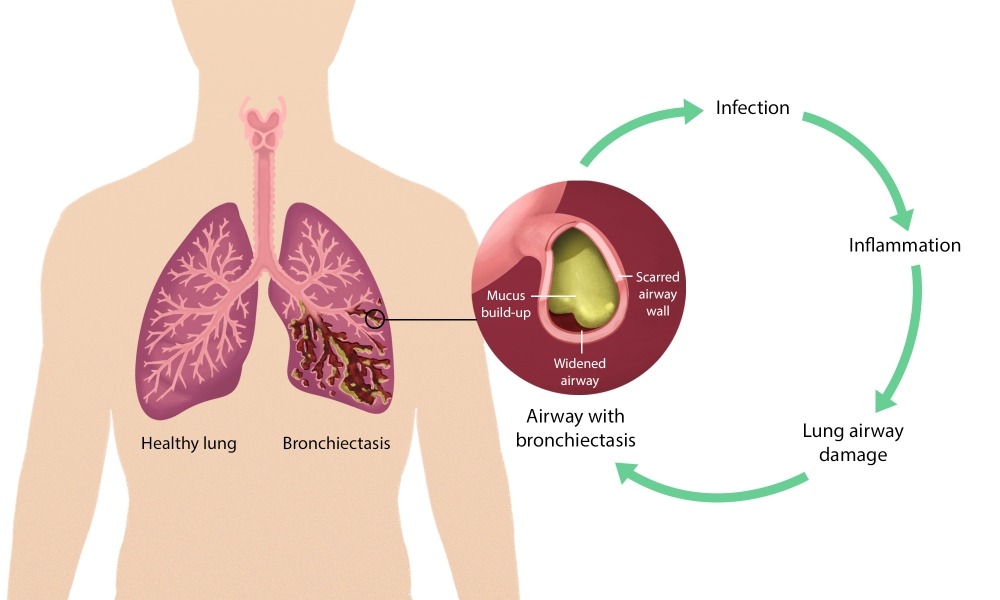Bronchiectasis is a chronic inflammatory respiratory disease of the airways involving dilation of the bronchi. According to some specialists, “it is irreversible that we will not be able to solve. We can only try to alleviate the possible complications to prevent them from progressing.” It affects the large airways and causes their enlarging.
It can be inherited if the baby is born with it or acquired Bronchiectasis if its shrinks after birth. It usually occurs first, thanks to an attack on the respiratory system, which is generally an inflammation that attacks the bronchial tree of the lungs.
Causes
One of the most common causes is recurrent infection or inflammation of the respiratory tract and bronchial mucosa. The cases of Bronchiectasis due to infection represent 35 per cent. Other possible symptoms are cystic fibrosis and some genetic conditions.
Immunodeficiencies, some systemic pathologies, congenital abnormalities and other diseases increase the risk of Bronchiectasis.
Symptoms
The symptoms in the patient are presented progressively. The time depends on the case. It can happen from a few weeks to years after the event that causes Bronchiectasis. The symptoms are varied and can include the following:
- Skin with blue colour.
- Halitosis or bad mouth breath.
- Chronic cough with fetid sputum (foul-smelling phlegm originating in the lungs) is accompanied by expectoration (expulsion of substances from the lungs through the mouth). It is more robust in the morning due to the secretions that the patient accumulates due to the night.
- Repeated bronchial infections.
- Swollen fingers in the most distal part (in a drumstick).
- Expectoration of blood originating in the bronchi or lungs.
- Fever.
- Cough when the patient lies down. The cough usually produces expectoration with pus.
- Fatigue.
- chest pain
- Pallor.
- Dyspnea or breathing problems.
- Weight reduction.
- Wheezing or sound makes the air generated in the airways when they are obstructed or congested.
Prevention
One of the prevention measures for this disease is to avoid lung infections, such as pneumonia. To prevent conditions such as measles or whooping cough, it is best to get vaccinated against them.
Tobacco and pollution are significant factors that increase the possibility of infection and, consequently, Bronchiectasis. Therefore, avoiding these habits and maintaining a tobacco-free environment is recommended.
Types
When cases of Bronchiectasis present other different dominant characteristics, the disease is considered as one more component in the clinical picture of the other pathology (such as, for example, in patients with extrinsic allergic alveolitis or cystic fibrosis ). Bronchiectasis can be classified in several ways:
- Congenital: in the case of patients born with Bronchiectasis.
- Acquired: it can be due to infections, localised bronchial obstructions (both extrinsic or originating in the lung or intraluminal caused by an external object) or bronchial damage due to chemical factors.
Caballero classifies Bronchiectasis into two types depending on its location:
- Localised: They appear in a specific lung area due to a localised infection.
- Diffuse: in patients with cystic fibrosis or immunodeficiencies.
According to the Spanish Association of Pediatrics (AEP), we can classify Bronchiectasis into two types in early-age patients :
- Primary: installed in patients with no other previous pathology. Bronchiectasis arises as a result of a respiratory infection that becomes chronic. One of the infections that stand out is caused by HIV, but they can be of various origins, such as caused by viruses, bacteria or tuberculosis, among other reasons.
- Secondary: Bronchiectasis is a complication of another previous disease such as cystic fibrosis, immunological defects, aspiration syndromes, asthma, bronchopulmonary aspergillosis, bronchial cartilage dysplasia or mucociliary clearance disorders.
Diagnosis
The doctor listens to the sounds from the patient’s chest to see if he can locate any abnormalities. Other imaging and diagnostic tests will also be performed, such as:
- Precipitin test for aspergillosis.
- Blood test.
- Chest X-ray.
- Sputum culture: laboratory examination in which the causes that originate a certain infection are sought.
- Complete blood analysis (Hemogram).
- Sweat test for cystic fibrosis.
- Skin tests to find out if the patient had tuberculosis in the past (tuberculin).
- Serum immunoglobulin electrophoresis: A test that measures antibodies from a blood test.
- Chest computed tomography.
- Bronchoscopy is a test that explores the airway and allows biological samples to be obtained.
- Ventilation-perfusion scintigraphy is a technique that involves the introduction of a radiopharmaceutical into the body that facilitates the location of areas affected by Bronchiectasis.



